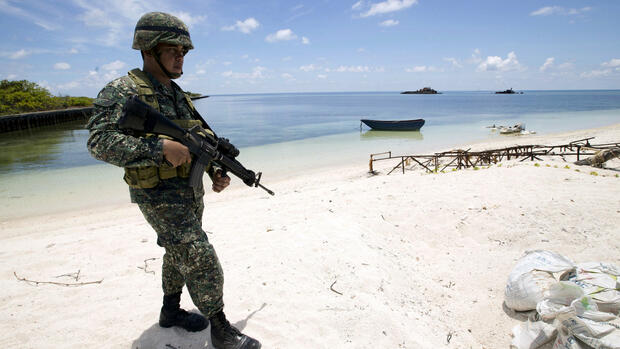According to the tour organizers, vacationers will have the opportunity, among other things, to exchange personal information with the armed forces stationed on the Spratly Islands.
(Photo: Reuters)
Bangkok The South China Sea is not exactly a place of longing for tourists. The sea area is best known for its many conflicts. China claims almost the entire region for itself and is building military bases on artificial islands.
The government in Beijing is constantly at odds with other neighboring countries such as Vietnam, Malaysia and the Philippines, which are also laying claim to the waters in their vicinity: the Chinese coast guard is pushing boats away, aiming lasers at them and using water cannons.
The Philippines are now reacting to the precarious situation with an unusual offer: adventure holidays in one of the most tense geopolitical hotspots in the world.
The new ship tour lasts seven days and six nights. It starts in Puerto Princesa, a coastal town on the Philippine holiday island of Palawan. From there, head west more than 300 kilometers to the disputed Spratly Islands, which six states claim in whole or in part.
The Philippines counts seven of the islands as part of its national territory. They call the Kalayaan region and the tourism initiative there “Great Kalayaan Expedition”. Only one of the islands controlled by the Philippines has a few hundred civilians – the rest are only held by Filipino soldiers.
The US and China accuse each other of provocative behavior
According to the tour organizers, holidaymakers who have been able to travel to the remote region since March have the opportunity, among other things, to exchange personal information with the armed forces stationed there. They certainly have a lot to tell: things have been getting increasingly hot lately in their area of operation. The United States, which sees China’s behavior in the region as a threat to free shipping, and the government in Beijing have repeatedly accused each other of provocative behavior in the water in recent weeks.
>> Read here: Preparation is everything: How Taiwan is arming itself for China’s possible attack
From the Philippines’ point of view, the new tourism offensive in the area should help to substantiate its claims: It is about showing a stronger presence and at the same time presenting China’s activities in the region more clearly to the public, said Dindo Manhit, head of the Philippine think tank Stratbase ADR Institutes.
The approach has role models: Malaysia operates a diving resort on an atoll in the Spartly Islands. China began cruising to the Paracel Islands in 2013, which are also claimed by Vietnam and Taiwan. A new 120-seat hotpot restaurant recently opened on one of them. Not only do guests come for the promise that the islands are “China’s Maldives,” many Chinese see the visit as an act of patriotism.
So far, foreigners have not been taken on Chinese cruises to the disputed region. The Philippines are more relaxed: According to the organizers, visitors from Switzerland, France and Australia also took part in the most recent edition of the “Great Kalayaan Expedition”. But the trip is not cheap: it costs 2,000 euros to examine the territorial conflict under the Philippine flag for a week.
More: Biden pledges military support to the Philippines
